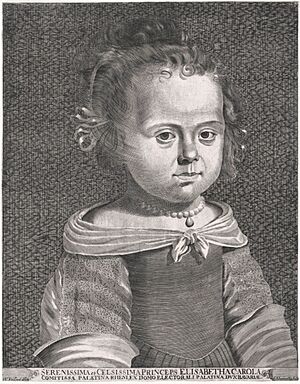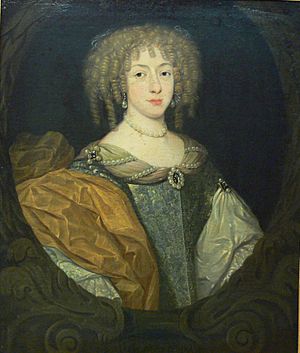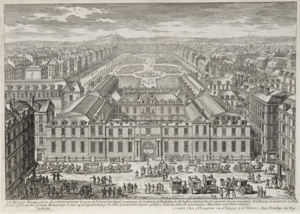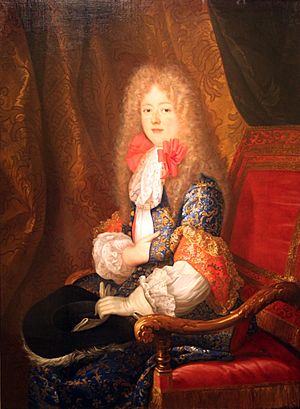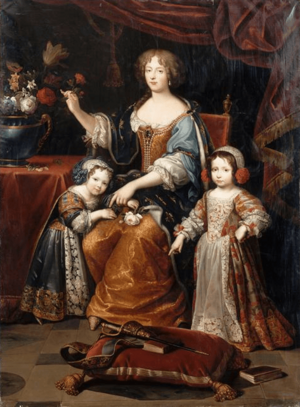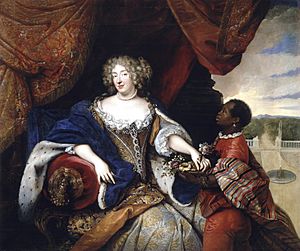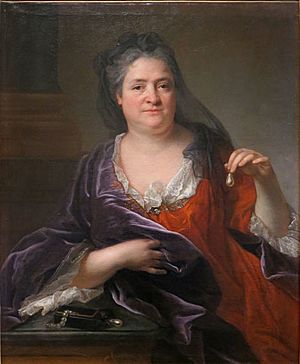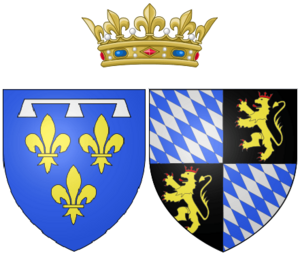Elizabeth Charlotte, Madame Palatine facts for kids
Quick facts for kids Princess Elizabeth Charlotte of the Palatinate |
|
|---|---|
| Duchess of Orléans | |
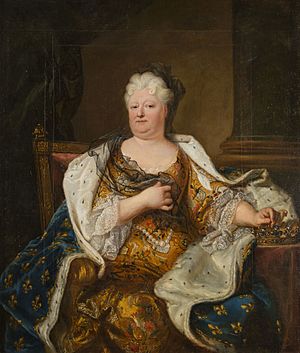
Portrait by Hyacinthe Rigaud, 1713
|
|
| Born | 27 May 1652 Heidelberg Castle, Heidelberg, Electoral Palatinate, Holy Roman Empire |
| Died | 8 December 1722 (aged 70) Château de Saint-Cloud, Île-de-France, Kingdom of France |
| Burial | Basilica of Saint Denis, France |
| Spouse | |
| Issue Detail |
|
| House | Palatinate-Simmern (by birth) Bourbon (by marriage) |
| Father | Charles I Louis, Elector Palatine |
| Mother | Landgravine Charlotte of Hesse-Kassel |
| Religion | Roman Catholicism prev. Calvinism |
| Signature | |
Princess Elizabeth Charlotte of the Palatinate (known as Liselotte von der Pfalz) was born on 27 May 1652. She passed away on 8 December 1722. She was a German princess from the House of Wittelsbach.
Liselotte became the Duchesse d'Orléans (Duchess of Orléans) when she married Philippe I, Duke of Orléans. He was the younger brother of Louis XIV of France, the Sun King. Liselotte was also the mother of Philippe II, Duke of Orléans, who later ruled France for a time. This period was called the Regency.
She is famous for the many letters she wrote. These letters give us a great look into what life was like at the French court. They are very important for understanding history and culture from that time. Her letters are some of the best-known German writings from the Baroque period.
Even though she had only two children who lived to be adults, Liselotte became an ancestor to many royal families in Europe. This is why she was sometimes called the "Grandmother of Europe." Her descendants include Louis Philippe I, who became King of France. Through her daughter, she was also the grandmother of Francis I, Holy Roman Emperor, and the great-grandmother of Marie Antoinette, the last Queen of France before the French Revolution.
Contents
Liselotte's Life Story
Her Early Years
Elizabeth Charlotte was born on May 27, 1652, at Heidelberg Castle. She was the only daughter of Charles I Louis, Elector Palatine, and his wife Landgravine Charlotte of Hesse-Kassel. She was named after her grandmother and mother. From a young age, people called her Liselotte, which was a mix of her two names.
Liselotte was a very active child. She loved to run and climb trees. She even said she wished she had been born a boy! In her letters, she called herself a "wild child."
Her parents' marriage was not happy. In 1657, her father separated from her mother. He then married another woman, Marie Luise von Degenfeld. Liselotte had a good relationship with many of her 13 half-siblings. She wrote letters to two of her half-sisters, Louise and Amalie Elisabeth, throughout her life. Her half-brother Charles Louis, called Karllutz, was her favorite. She was very sad when he died young in battle.
Liselotte's aunt, Sophia of Hanover, was very important to her. In 1659, Liselotte's father sent her to live with her aunt in Hanover. Liselotte later said this was the happiest time of her life. Sophia became like a mother to her. She was Liselotte's most trusted friend and letter-writer for many years.
During this time, Liselotte visited The Hague. There, she met her grandmother, Elizabeth Stuart, the "Winter Queen" of Bohemia. Liselotte's grandmother liked her very much. She said Liselotte was like her own family, the Stuarts. Liselotte also played with William III of England, who later became King of England. By 1661, Liselotte spoke French very well.
In 1663, Liselotte's father brought her back to Heidelberg. She began to receive a proper education for a princess. She learned French, dancing, music, and history. She was also taught to be tolerant of different religions. This was unusual for the time. Her father, who was a Calvinist, allowed different Christian groups to worship together. Liselotte learned about different faiths. She was required to become Catholic before her marriage. But she remained open-minded about religion throughout her life.
Her Marriage and New Home

In 1671, Liselotte married Philippe I, Duke of Orléans. He was the younger brother of King Louis XIV of France. Philippe was known as "Monsieur." As his wife, Liselotte was called "Madame." This marriage was arranged for political reasons. Liselotte's aunt, Anna Gonzaga, helped arrange the wedding. She also helped with Liselotte's conversion to Catholicism.
The wedding happened on November 16, 1671, in Metz. The day before, Liselotte officially changed her religion to Roman Catholic. She met her husband, who was 12 years older, on November 20, 1671.
Liselotte lived in her own apartments in her husband's homes. These included the Palais Royal in Paris and the Château de Saint-Cloud. They also spent most of their time at the royal court. They lived at the Château de Saint-Germain-en-Laye and later at the Palace of Versailles. They also visited the Palace of Fontainebleau for hunting season. Liselotte loved hunting and often rode with the King. She had her own staff of 250 people.
Philippe had two daughters from his first marriage. Liselotte became very close to his older daughter, Marie-Louise. She loved his younger daughter, Anne Marie, like her own child.
Liselotte and Philippe had three children together.
Life at the Court of Louis XIV
Liselotte became very close to her brother-in-law, King Louis XIV. He found her witty and charming. He enjoyed her open and humorous personality. They often went hunting together, which was unusual for a noble lady. She also loved long walks. The King noticed this and said she was the only one who truly enjoyed the beauty of Versailles.
Even though she wasn't considered beautiful and was a bit unconventional, Liselotte made a good impression. People at court expected a "rough" foreigner. But they soon praised her "charming directness" and good sense.
Her Children
Liselotte and Philippe I of Orléans had three children:
- Alexandre Louis d'Orléans, Duke of Valois (1673–1676). He died before his third birthday. Liselotte was very sad about his death.
- Philippe d'Orléans (1674–1723). He became Duke of Orléans in 1701. He later became the Regent of France.
- Élisabeth Charlotte d'Orléans (1676–1744). She married Leopold, Duke of Lorraine. She was the grandmother of Queen Marie Antoinette.
Liselotte had a loving relationship with her children. She was heartbroken when her first son died. Her younger son, Philippe, looked like her and shared her interests. Their relationship improved over time.
Challenges and Sadness
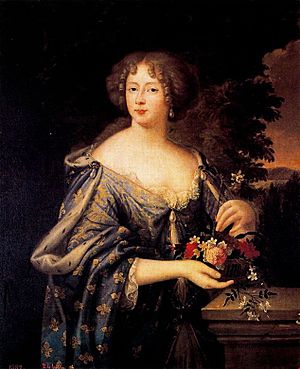
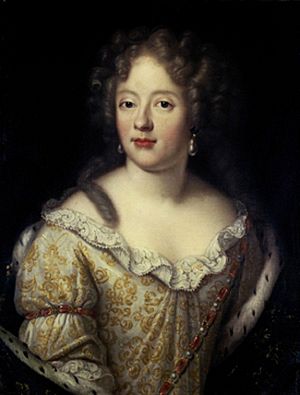
Around 1680, Liselotte faced problems in her marriage. Her husband's friends tried to reduce her influence on him. Her own trusted friends were dismissed from court. This left her feeling alone.
Her relationship with the King also changed. His mistress, Madame de Maintenon, gained more power. Louis XIV became less likely to help Liselotte in her disagreements with his brother. Liselotte disliked Madame de Maintenon because of her low social rank and desire for power. As Madame de Maintenon's influence grew, Liselotte was less often invited to the King's private gatherings.
In 1685, King Louis XIV issued the Edict of Fontainebleau. This ended religious tolerance for Protestants in France, known as Huguenots. Many French Protestants left the country. Liselotte, who was originally Protestant, found this situation difficult.
When her brother, Charles II, Elector Palatine, died in 1685, the King claimed the Electoral Palatinate for Liselotte. This led to the Nine Years' War. Her homeland, including Heidelberg Castle, was destroyed. This was very upsetting for Liselotte. She was sad about her brother's death and the destruction of her home.
In 1692, Liselotte was very upset when Louis XIV arranged for her son, Philippe, to marry his daughter, Françoise Marie de Bourbon. This daughter was born out of wedlock. Liselotte and others at court saw this marriage as a humiliation. She was very angry and sad.
In 1693, Liselotte became very ill with smallpox. She survived, but her face was left scarred. She didn't mind much, as she had always thought she was not beautiful. After her illness, she gained a lot of weight. This made her walks harder, but she still enjoyed hunting.
Her Widowhood
On June 9, 1701, her husband, the Duke of Orléans, died. He left behind many debts. Liselotte wisely decided not to take on his property. She feared the King might send her to a convent, as her marriage contract allowed. So, she tried to make peace with Madame de Maintenon. She told the King that she had hated Madame de Maintenon only because she felt she was losing the King's favor.
After her husband's death, Liselotte continued to live at Versailles. She still took part in court activities, including hunts. She and the King would ride in a carriage together. She avoided the Palais Royal and Saint Cloud until 1715, so as not to bother her son and his wife.
The Régence and Her Final Years
King Louis XIV died on September 1, 1715. He had ruled for over 72 years. Liselotte was one of the last people he spoke to. After the King's death, Liselotte's son, Philippe II, Duke of Orléans, became the Regent of France. This meant he ruled the country because the new king, Louis XV of France, was only 5 years old. This period was known as the Régence. Liselotte became the most important lady at court.
Liselotte did not usually get involved in politics. But one month after Louis XIV's death, she helped free Protestants who had been imprisoned for their beliefs. She helped release over 200 people.
Liselotte was interested in opera and theater. She also loved to read and had a library of over 3,000 books. These included novels, plays, and classical authors. She also had books on natural history, medicine, and mathematics. She collected old gold coins and owned three of the newly invented microscopes. She used them to look at insects. She spent her days writing letters, reading, and learning.
In June 1722, she visited Versailles for the last time. She died on December 8, 1722, at the Château de Saint-Cloud, at the age of 70. She was buried in the royal burial place at the Basilica of Saint-Denis. Her son was very sad about her death. He died only a year later.
Her Famous Letters
Liselotte wrote an amazing number of letters during her life. It's thought she wrote about 60,000 letters! About 5,000 of these letters still exist today. She wrote two-thirds of them in German and one-third in French. This makes her one of the most important letter writers of her time.
Her letters cover all parts of life. They describe court life in a lively and often funny way. She shared memories of her childhood in Germany. She also wrote about the latest gossip from royal courts across Europe. She shared her thoughts on books, theater, and life in general. Writing letters helped her feel better when she was sad. It also helped her keep her German language skills, which was important to her identity.
Her German letters often mixed in French words and phrases. This happened especially when she wrote about conversations with King Louis XIV or her husband. Liselotte used very direct language in her letters. She liked to use striking comparisons and proverbs. Her favorite saying was: "What cannot be changed, let go as it goes."
Liselotte did not write her letters for others to read later. She wrote them only for the person she was sending them to. This is why her letters feel so natural and personal. She often said, "I write as I speak." She probably thought her letters would be destroyed after they were read. Luckily, many of them survived.
Most of her letters were sent to her aunt, Sophia of Hanover, Electress of Hanover. She wrote to her aunt twice a week. Sophia was a strong person who supported Liselotte. Liselotte also wrote regularly to her half-sisters, Luise and Amalie Elisabeth. She kept in touch with her German teachers and friends.
Sadly, many of her French letters to her daughter, the Duchess of Lorraine, were destroyed in a fire in 1719. Later in life, she also wrote to Caroline of Ansbach, who became Queen of Great Britain. Liselotte also wrote to other relatives and important people, like the famous philosopher Gottfried Wilhelm Leibniz.
Liselotte knew that her letters were sometimes opened and read by government officials. She would even write funny remarks directly to them in her letters! Her most honest letters were those she sent with travelers, not through the official mail. In these, she could freely express her feelings about her husband's friends and her dislike for Madame de Maintenon.
Her letters give us a special look into court life during the Baroque period. They also show us her lively personality. She wrote without trying to be a great writer. She just wrote what she thought and felt.
Her Appearance and Personality
Liselotte was described as strong and a bit masculine. She had the energy to hunt all day. She refused to wear a mask to protect her skin, unlike other French women. Because of this, her face became ruddy from the sun and wind. She walked very fast, and few people could keep up with her, except the King. She had a very direct and practical attitude.
She enjoyed eating, and as she got older, she gained weight. She once joked that she would be as good to eat as a roasted pig! She was raised as a Protestant and didn't like long Catholic church services. Her opinions were often different from those common at the French court.
She was known by many names and titles. These included Princess Palatine, of the Palatinate, and of the Rhine. At the French court, after her marriage, her official title was "Her Royal Highness, Madame, Duchess of Orléans." But she was most commonly known simply as Madame. This was a special title given to the wife of the King's younger brother.
Her Legacy
In 1788, parts of Liselotte's letters were first published in French. A few years later, they appeared in German. People at the time of the French Revolution saw her as an important witness to the problems of the old royal system. Her letters became popular in Germany. She was seen as a moral and honest German princess living among the French court. Her letters showed her dislike for French ways and her love for everything German.
Later, in the 19th century, her letters became less about politics. But they remained important for their cultural and historical value. German nationalist movements used her letters to promote anti-French ideas. Liselotte was seen as a brave German woman who suffered at the French court. She became a national hero in Germany.
Fashion Influence
The palatine is a type of short cape or fur collar. It is named after Liselotte. Women wore it to keep their necks and chests warm in winter. When Liselotte first arrived from Heidelberg, people at the French court made fun of her "old" furs. But she was popular with the King. So, during a very cold winter in 1676, other ladies started to copy her style. This led to the palatine becoming a popular fashion item for centuries.
Liselotte in Popular Culture
- 1932: Liselott - A musical play by Richard Keßler.
- 1935: Liselotte von der Pfalz - A German film.
- 1943: Liselotte - Ein Roman aus dem Leben der Elisabeth Charlotte von der Pfalz - A novel about her life.
- 1966: Liselotte von der Pfalz - Another German film.
- 2014: A Little Chaos - A British film where Liselotte was played by Paula Paul.
- 2017–2018: Versailles - A BBC TV series where Liselotte was played by Jessica Clark.
Titles and styles
- 27 May 1652 – 16 November 1671: Her Serene Highness Princess Palatine Elisabeth Charlotte
- 16 November 1671 – 9 June 1701: Her Royal Highness The Duchess of Orléans
- 9 June 1701 – 8 December 1722: Her Royal Highness The Dowager Duchess of Orléans
- Madame was the most common way she was addressed after her marriage.
See also
 In Spanish: Isabel Carlota del Palatinado para niños
In Spanish: Isabel Carlota del Palatinado para niños


